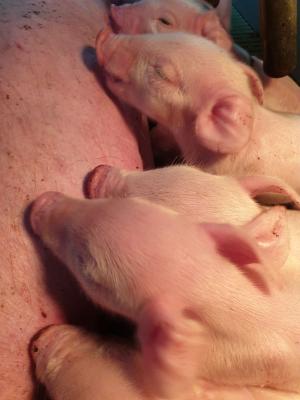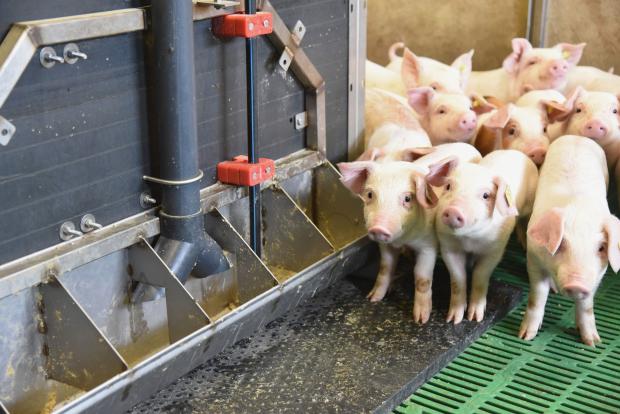New research findings on optimising the potential of small pigs
Date published:
Over the past four years, pig researchers at the Agri-Food and Biosciences Institute (AFBI) have been working on a major project entitled ‘Understanding and overcoming the barriers posed by small pigs’.

The work was co-funded between DAERA and Pig ReGen Ltd and as the title suggests, its main aim was to better understand the implications (for the farmer and for the animal) of having to deal with the increased number of small pigs born in large litters.
A further aim was to identify management and nutritional strategies that could boost the performance and welfare of small pigs. Lastly, the project also studied a new feeding system (similar to liquid feeding but only mixing water and diet at the point of delivery to the animals) that had recently been installed at both the nursery and finisher facilities in AFBI Hillsborough.
The work has generated some very interesting results which will be of interest to farmers and the wider pig industry. These results have been compiled into technical reports and a series of 8 presentations which can be viewed through AFBI’s YouTube channel.
In this first instalment, 3 presentations aligned to Dr Samuel Hawe’s PhD work are highlighted. (Presentation 1 What is the significance of compromised pigs on commercial farms?) overviews the findings from Samuel’s work which quantified the performance of piglets born with low birth weight on 4 Northern Irish farms. The study showed that piglets born with low birth weight (<1.0 kg of live weight) were almost 10 kg lighter at slaughter than their counterparts. The study showed that most of the mortality among low birth weight piglets occurred pre-weaning, suggesting that improving lactation nutrition should be a primary focus of intervention. In addition, the study found that during the nursery stage the difference between low birth weight piglets and their heavier counterparts was bigger than in any other stage. This finding suggests that nursery stage should be the target stage in order to improve low birth weight piglets performance.
Following from the first study, (Presentation 2 Growth response of low and average birthweight pigs to sow lactation feed intake) studied the benefits of increasing sow lactation feed intake on the pre weaning growth rate of the litter. The study showed that sows in Northern Ireland have the capacity to reach average feed intakes of 8.6 kg/day (peak daily intake of 11kg), 2 kg above the national average. In addition, the increased feed intake by the sows resulted in low birth weight piglets reaching weaning weights of ~7.9 kg, similar to their counterparts from sows with a national average feed intake.

The conventional regime, in which post-weaning diets are introduced to pigs based on age was compared with a ‘tailored regime’ where post-weaning diets were introduced to pigs based on their body weight, allowing the animal to reach the necessary development before being fed a lower quality diet. Firstly, the study found that the positive impact of higher lactation intake by the sows on piglets’ weaning weight, was not maintained post-weaning. Highlighting the need to introduce further measures post-weaning. Secondly, the study found that allowing the pigs to reach a desired body weight before introducing a new diet resulted in improved performance of small pigs. Grouping your pigs in pens by body weight and allowing the smaller ones extra time to reach the target weight before introducing the next diet could be a simple solution to improve overall performance without the need of introducing new diets on the farm.
AFBI’s Dr Ramon Muns, who is the Head of the Monogastric Research Group in AFBI said: “In most of the cases, farmers know that better nutrition and better feeding management will improve the performance of their pigs and especially of the smaller ones. However, farmers are constrained by workforce, time and production costs. Hopefully, the results reported in this series of presentations will help farmers target their efforts in such a way which maximising the return on investment. For instance, if you don’t have time to spend increasing the feed intake of all the sows in the farrowing room, gather the small piglets in a few sows and focus on those reduced number of sows. If you can afford to introduce higher specification diets for your small piglets but not across all the rearing process, focus on the nursery stage. If it is not possible to introduce extra or higher specification diets, work with the same ones you have but don’t follow blindly a set allowance or calendar, look at the animals before changing diets, be sure they all have reached the desirable weight before introducing the next diet.
In Summary to view the first three presentations please see below:
Presentation 1: What is the significance of compromised pigs on commercial farms?
Presentation 2: Growth response of low and average birthweight pigs to sow lactation feed intake.
Presentation 3: Tailored post-weaning feeding regime for low birthweight pigs) followed animals from weaning to finish.
Notes to editors:
AFBI is an arms-length body of DAERA delivering research and development, diagnostic and analytical testing, emergency response capability and expert scientific advice for DAERA and other government departments, public bodies and commercial companies in Northern Ireland, and further afield.AFBI’s Vision is “Advancing the Local and Global Agri-Food Sectors Through Scientific Excellence”.AFBI’s core areas:Leading improvements in the agri-food industry;Protecting animal, plant and human health;Enhancing the natural and marine environment.